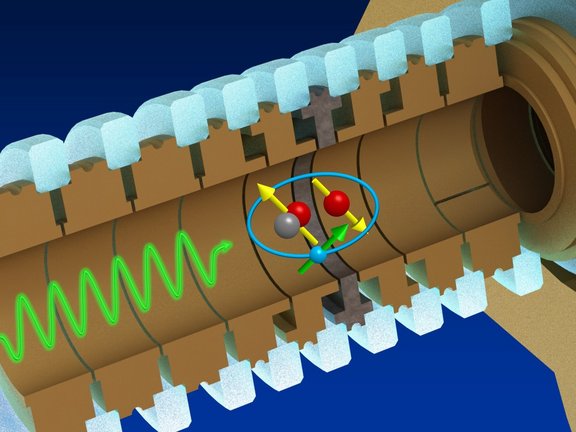|
The search for new physics beyond current fundamental theories and stringent tests of their validity are one of main challenges of modern science. High-precision, low-energy experiments on atomic and molecular systems provide new insights in this field, complementary to accelerator-based, high-energy experiments. Of particular interest are few-body systems, containing only a single or a few electrons, because these can be calculated with ultra-high precision. The prediction can then be compared to equally precise measurements, probing the validity of our fundamental theories. Compared to atomic ions, molecular hydrogen ions have additional degrees of freedom. The nuclei in the molecule can rotate and vibrate, giving rise to a rich structure of quantum states, the so-called rovibrational structure. The transition frequencies between these levels depend on the basic interactions as well as on fundamental natural constants, particularly the masses of the nuclei and the electron, and can be measured with extremely high precision.
The group around Sven Sturm at the Max Planck Institute for Nuclear Physics (MPIK) in Heidelberg, in collaboration with the group of Stephan Schiller from Heinrich Heine University of Düsseldorf, has now demonstrated a nondestructive internal quantum state detection for single HD+ ions as well as several month-long trapping of this species, using the cryogenic Penning trap ALPHATRAP. This heteronuclear test system containing a proton and a deuteron was chosen because of easier and fast rovibrational ground state preparation and the availability of high precision spectroscopic and theoretical data to compare with. Charlotte König, first author of the publication explains: “The new technique is equally applicable to the homonuclear H2+ ion, which is particularly difficult to control due to its rovibrational decay times in the range from weeks to centuries.”
This represents an important milestone towards a possible future high-precision comparison of H2+ and its antimatter counterpart H̅2– (consisting of two antiprotons and a positron), which would allow probing the fundamental matter/antimatter symmetry (CPT invariance of the laws of physics under simultaneous inversion of charge, space and time). In the future, the production of molecular anti-hydrogen ions at the antimatter facility at CERN might become possible, but even then likely with very low production rates. The newly-developed techniques then yield an ideal toolbox to perform precision experiments on the precious antimatter molecular ions.
Original publication:
Nondestructive control of the rovibrational ground state of a single molecular hydrogen ion in a Penning trap
Charlotte M. König, Fabian Heiße, Jonathan Morgner, Tim Sailer, Bingsheng Tu, Dimitar Bakalov, Klaus Blaum, Stephan Schiller and Sven Sturm
Physical Review Letters 134, 163001 (2025). DOI: 10.1103/PhysRevLett.134.163001
Weblinks:
Group “Lepton Symmetry Experiment” (LSym) at MPIK
